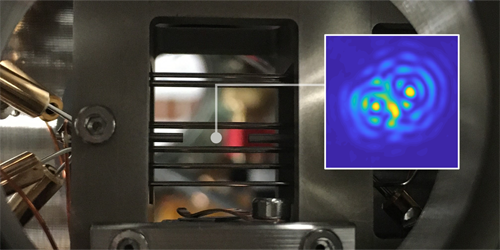Mirror Image Pinpoints a Nanoparticle’s Position
Recently, researchers reduced the motion of a nanoparticle suspended in an optical trap almost to its quantum ground state (see Synopsis: Levitated Nanoparticle Goes Quantum). Particles with such low “center-of-mass temperatures” offer a long-sought platform for studying the quantum behavior of macroscopic objects and for performing various sensing tasks. But achieving this quantum regime remains out of reach for particles confined in electrical or magnetic ion traps because the limited optical access in such experiments makes detecting the particles’ slightest motion challenging. To solve that problem, Lorenzo Dania, at the University of Innsbruck, Austria, and his colleagues have introduced a new technique for measuring the position of a levitated nanoparticle in an ion trap [1]. Their method, which detects the particle’s position relative to its mirror image, outperforms current state-of-the-art detection methods.
The team loaded a 300-nm-diameter silica sphere into a standard electrical trap situated between a movable mirror and a photodetector and illuminated it with a laser beam. Light scattered by the particle could take two pathways: a direct one to the detector and an indirect one via reflection off the mirror. Those two pathways created an interference signal that, when captured by the photodetector, precisely encoded the particle’s position. Compared to a standard motion-detection method based on direct transmission of independent laser beams, the self-interference signal showed a 38-dB-higher signal-to-noise ratio. This improvement makes it possible to identify movements of the particle that would have otherwise been drowned in noise.
By allowing a particle in an electrical or magnetic trap to be cooled to its quantum ground state, the result could enable quantum experiments with macroscopic objects in an environment free of light-induced disturbances.
–Rachel Berkowitz
Rachel Berkowitz is a Corresponding Editor for Physics Magazine based in Vancouver, Canada.
References
- L. Dania et al., “Position measurement of a levitated nanoparticle via interference with its mirror image,” Phys. Rev. Lett. 129, 013601 (2022).




